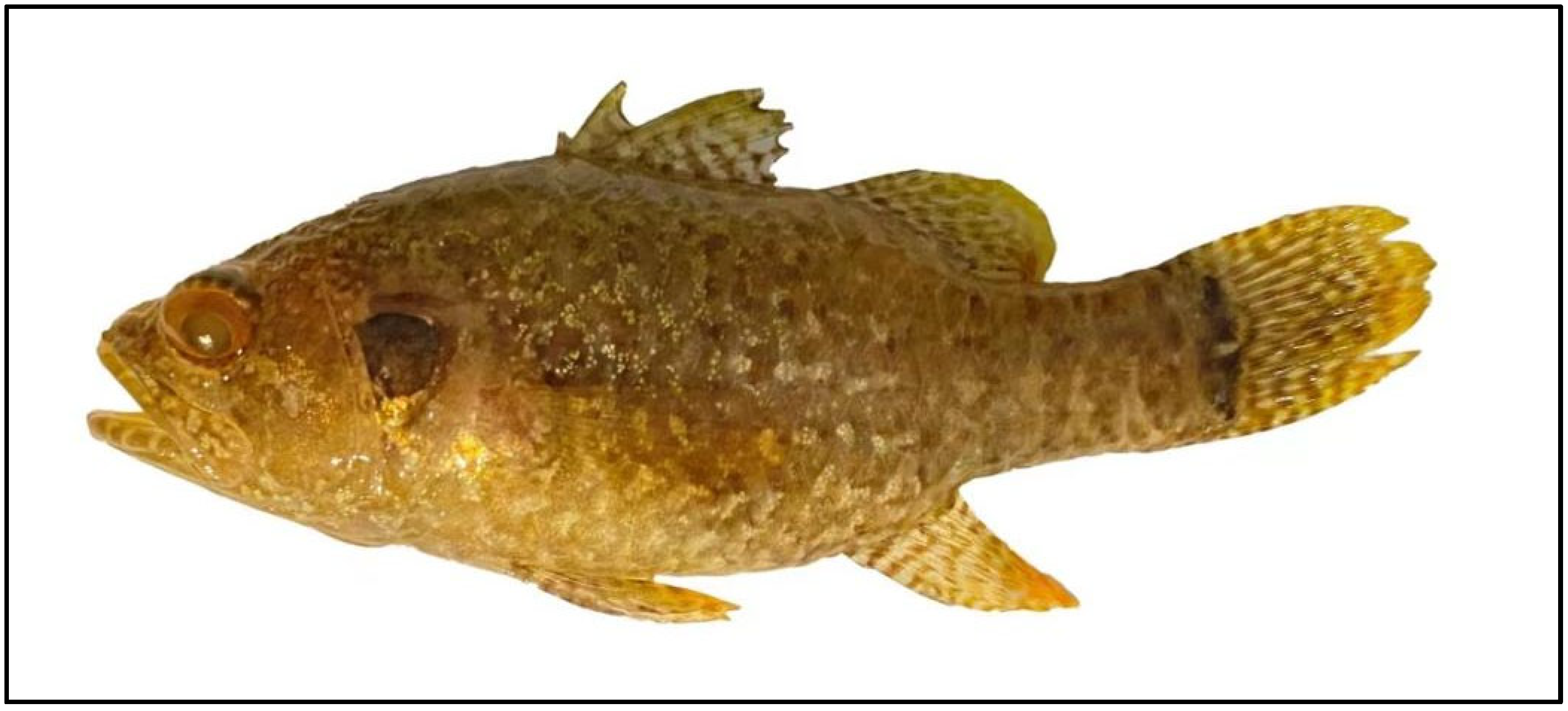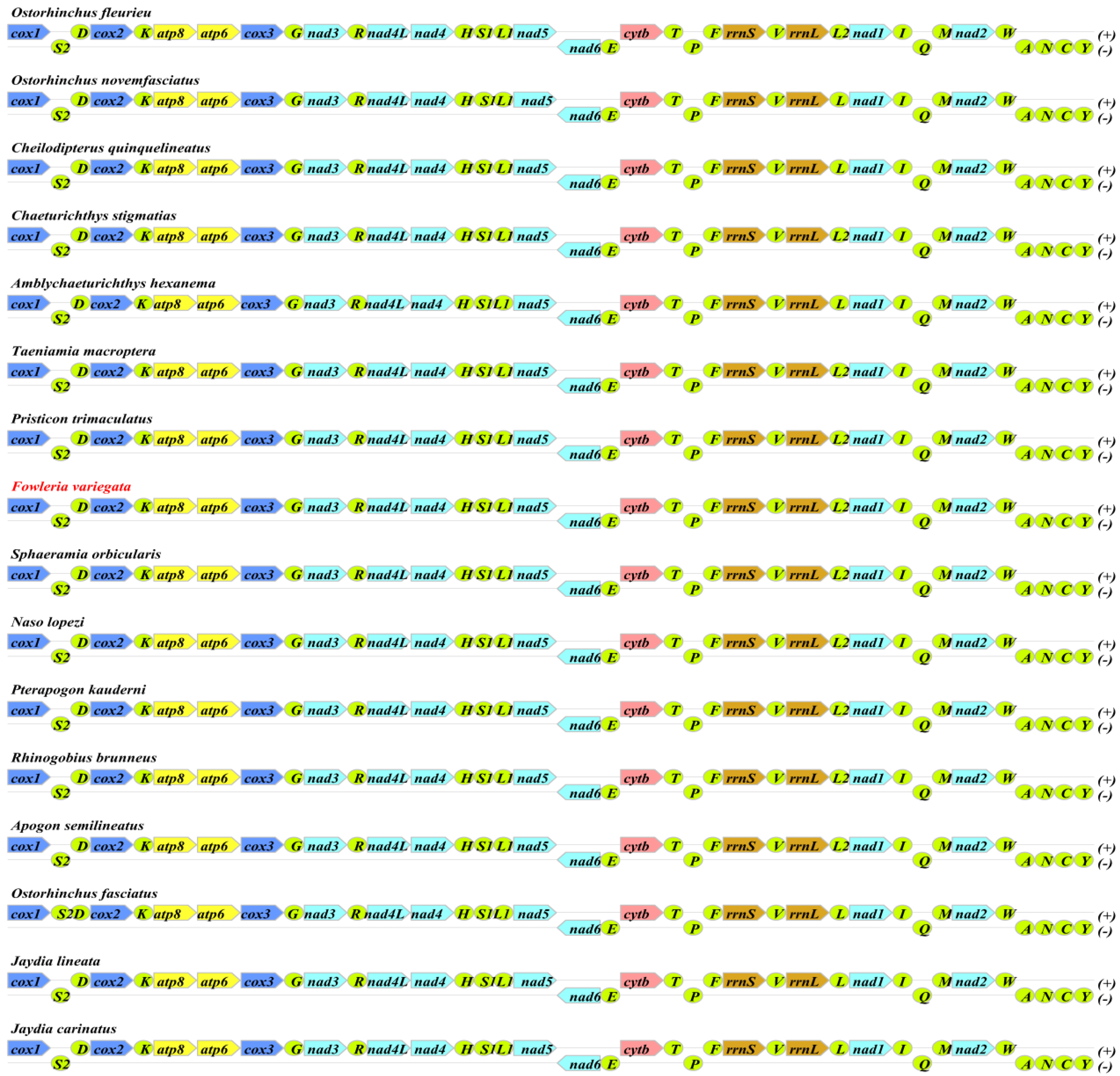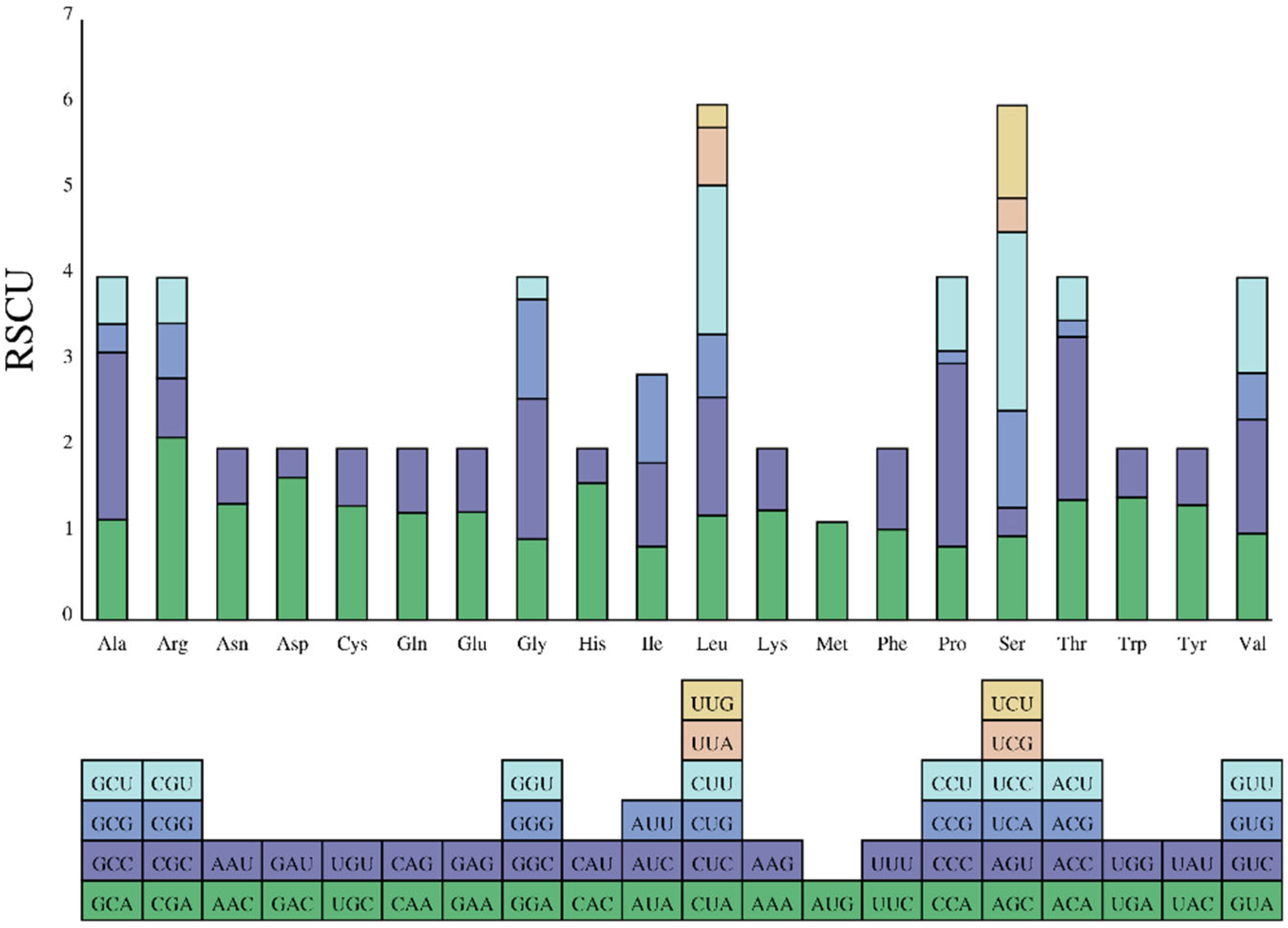A Comprehensive Analysis of the Fowleria variegata (Valenciennes, 1832) Mitochondrial Genome and Its Phylogenetic Implications within the Family Apogonidae
Abstract
1. Introduction
2. Materials and Methods
2.1. Ethical Approval for Research Protocols
2.2. Experimental Fish and Sampling
2.3. F. variegata Mitogenome Assembly and Annotation
2.4. Assessment of Sequence Properties
2.5. Phylogenetic Analyses
3. Observations and Insights
3.1. Genomic Organization and Nucleotide Composition
3.2. Analysis of Mitochondrial Protein-Coding Genes
3.3. Phylogenetic Analyses
4. Summary
Supplementary Materials
Author Contributions
Funding
Institutional Review Board Statement
Informed Consent Statement
Data Availability Statement
Conflicts of Interest
References
- Chang, H.-J.; Mok, H.-K.; Fine, M.L.; Soong, K.; Chen, Y.-Y.; Chen, T.-Y. Vocal Repertoire and Sound Characteristics in the Variegated Cardinalfish, Fowleria Variegata (Pisces: Apogonidae). J. Acoust. Soc. Am. 2022, 152, 3716–3727. [Google Scholar] [CrossRef] [PubMed]
- Mabuchi, K.; Fraser, T.H.; Song, H.; Azuma, Y.; Nishida, M. Revision of the Systematics of the Cardinalfishes (Percomorpha: Apogonidae) Based on Molecular Analyses and Comparative Reevaluation of Morphological Characters. Zootaxa 2014, 3846, 151–203. [Google Scholar] [CrossRef] [PubMed]
- Fishelson, L.; Delarea, Y.; Zverdling, A. Taste Bud Form and Distribution on Lips and in the Oropharyngeal Cavity of Cardinal Fish Species (Apogonidae, Teleostei), with Remarks on Their Dentition. J. Morphol. 2004, 259, 316–327. [Google Scholar] [CrossRef] [PubMed]
- Sasal, P.; Mouillot, D.; Fichez, R.; Chifflet, S.; Kulbicki, M. The Use of Fish Parasites as Biological Indicators of Anthropogenic Influences in Coral-Reef Lagoons: A Case Study of Apogonidae Parasites in New-Caledonia. Mar. Pollut. Bull. 2007, 54, 1697–1706. [Google Scholar] [CrossRef] [PubMed]
- Thacker, C.E.; Roje, D.M. Phylogeny of Cardinalfishes (Teleostei: Gobiiformes: Apogonidae) and the Evolution of Visceral Bioluminescence. Mol. Phylogenetics Evol. 2009, 52, 735–745. [Google Scholar] [CrossRef] [PubMed]
- Sergi, D.; Naumovski, N.; Heilbronn, L.K.; Abeywardena, M.; O’Callaghan, N.; Lionetti, L.; Luscombe-Marsh, N. Mitochondrial (Dys) Function and Insulin Resistance: From Pathophysiological Molecular Mechanisms to the Impact of Diet. Front. Physiol. 2019, 10, 532. [Google Scholar] [CrossRef] [PubMed]
- Mishmar, D.; Levin, R.; Naeem, M.M.; Sondheimer, N. Higher Order Organization of the MtDNA: Beyond Mitochondrial Transcription Factor A. Front. Genet. 2019, 10, 1285. [Google Scholar] [CrossRef]
- Boore, J.L. Animal Mitochondrial Genomes. Nucleic Acids Res. 1999, 27, 1767–1780. [Google Scholar] [CrossRef]
- Machado, D.J.; Lyra, M.L.; Grant, T. Mitogenome Assembly from Genomic Multiplex Libraries: Comparison of Strategies and Novel Mitogenomes for Five Species of Frogs. Mol. Ecol. Resour. 2016, 16, 686–693. [Google Scholar] [CrossRef]
- Sun, C.-H.; Liu, H.-Y.; Xu, N.; Zhang, X.-L.; Zhang, Q.; Han, B.-P. Mitochondrial Genome Structures and Phylogenetic Analyses of Two Tropical Characidae Fishes. Front. Genet. 2021, 12, 627402. [Google Scholar] [CrossRef]
- Jin, J.-J.; Yu, W.-B.; Yang, J.-B.; Song, Y.; Yi, T.-S.; Li, D.-Z. GetOrganelle: A Simple and Fast Pipeline for de Novo Assembly of a Complete Circular Chloroplast Genome Using Genome Skimming Data. BioRxiv 2018, 2018, 256479. [Google Scholar]
- Li, H. Aligning Sequence Reads, Clone Sequences and Assembly Contigs with BWA-MEM. arXiv 2013, arXiv:1303.3997. [Google Scholar]
- Walker, B.J.; Abeel, T.; Shea, T.; Priest, M.; Abouelliel, A.; Sakthikumar, S.; Cuomo, C.A.; Zeng, Q.; Wortman, J.; Young, S.K.; et al. Pilon: An Integrated Tool for Comprehensive Microbial Variant Detection and Genome Assembly Improvement. PLoS ONE 2014, 9, e112963. [Google Scholar] [CrossRef] [PubMed]
- Meng, G.; Li, Y.; Yang, C.; Liu, S. MitoZ: A Toolkit for Animal Mitochondrial Genome Assembly, Annotation and Visualization. Nucleic Acids Res. 2019, 47, e63. [Google Scholar] [CrossRef] [PubMed]
- Greiner, S.; Lehwark, P.; Bock, R. OrganellarGenomeDRAW (OGDRAW) Version 1.3.1: Expanded Toolkit for the Graphical Visualization of Organellar Genomes. Nucleic Acids Res. 2019, 47, W59–W64. [Google Scholar] [CrossRef] [PubMed]
- Iriarte, A.; Lamolle, G.; Musto, H. Codon Usage Bias: An Endless Tale. J. Mol. Evol. 2021, 89, 589–593. [Google Scholar] [CrossRef] [PubMed]
- Rozas, J.; Sánchez-DelBarrio, J.C.; Messeguer, X.; Rozas, R. DnaSP, DNA Polymorphism Analyses by the Coalescent and Other Methods. Bioinformatics 2003, 19, 2496–2497. [Google Scholar] [CrossRef] [PubMed]
- Katoh, K.; Standley, D.M. MAFFT Multiple Sequence Alignment Software Version 7: Improvements in Performance and Usability. Mol. Biol. Evol. 2013, 30, 772–780. [Google Scholar] [CrossRef]
- Kalyaanamoorthy, S.; Minh, B.Q.; Wong, T.K.F.; von Haeseler, A.; Jermiin, L.S. ModelFinder: Fast Model Selection for Accurate Phylogenetic Estimates. Nat. Methods 2017, 14, 587–589. [Google Scholar] [CrossRef]
- Nguyen, L.-T.; Schmidt, H.A.; von Haeseler, A.; Minh, B.Q. IQ-TREE: A Fast and Effective Stochastic Algorithm for Estimating Maximum-Likelihood Phylogenies. Mol. Biol. Evol. 2015, 32, 268–274. [Google Scholar] [CrossRef]
- Ronquist, F.; Huelsenbeck, J.P. MrBayes 3: Bayesian Phylogenetic Inference under Mixed Models. Bioinformatics 2003, 19, 1572–1574. [Google Scholar] [CrossRef] [PubMed]
- Pan, Y.; Chen, J.; Liu, C.; Zeng, L.; Zhao, X. The Complete Mitochondrial Genome of Archamia macropterus (Perciformes; Apogonidae) and Phylogenetic Studies of Perciformes. Mitochondrial DNA Part B 2019, 4, 3740–3741. [Google Scholar] [CrossRef] [PubMed]
- Matias, A.M.; Hereward, J. The Complete Mitochondrial Genome of the Five-Lined Cardinalfish Cheilodipterus quinquelineatus (Apogonidae). Mitochondrial DNA Part B 2018, 3, 521–522. [Google Scholar] [CrossRef] [PubMed]
- Xia, L.; Zhang, J. Phylogenetic Analysis of the Complete Mitochondrial Genome of Jaydia carinatus (Kurtiformes; Apogonidae). Mitochondrial DNA Part B 2020, 5, 1136–1137. [Google Scholar] [CrossRef]
- Ji, D.; Sun, Z.; Song, N.; Gao, T.; Xu, S. The Complete Mitochondrial Genome of Jaydia lineata (Perciformes, Apogonidae) Obtained by next-Generation Sequencing. Mitochondrial DNA Part B 2020, 5, 2507–2508. [Google Scholar] [CrossRef]
- Da, F.; Wen, Z.-Y. Complete Mitochondrial Genome of Broadbanded Cardinalfish (Ostorhinchus fasciatus) and Phylogenetic Analysis. Mitochondrial DNA Part B 2020, 5, 398–399. [Google Scholar] [CrossRef] [PubMed]
- Zhu, K.; Gao, Y.; Yuan, P.; Cao, P.; Ying, X.; Tao, H.; Liu, B. The Complete Mitochondrial Genome of Ostorhinchus Fleurieu (Kurtiformes: Apogonidae) and Phylogenetic Studies of Apogoninae. Mitochondrial DNA Part B 2019, 4, 3691–3692. [Google Scholar] [CrossRef] [PubMed]
- Sun, Y. Characterization of the Complete Mitochondrial Genome of Ostorhinchus Novemfasciatus and Phylogenetic Studies of Apogoninae. Mitochondrial DNA Part B 2021, 6, 31–32. [Google Scholar] [CrossRef] [PubMed]
- Jo, S.; Jung, S.-H.; Hwang, H.-J.; Kim, M.-S.; Kim, Y.-C.; Yoo, J.S.; Song, H.Y. Complete Mitochondrial Genome of Pristicon trimaculatus (Kurtiformes, Apogonidae): Mitogenome Characterization and Phylogenetic Analysis. Mitochondrial DNA Part B 2019, 4, 288–289. [Google Scholar] [CrossRef]
- Song, H.Y.; Hwang, H.-J.; Jo, S.; Jung, S.-H.; Kim, Y.C.; Yoo, J.S. Characterization of the Complete Mitochondrial Genome of Sphaeramia orbicularis (Kurtiformes, Apogonidae). Mitochondrial DNA Part B 2019, 4, 168–169. [Google Scholar] [CrossRef]
- Zheng, J.; Chen, B.; Gao, T.; Song, N. The Mitochondrial Genome of Chaeturichthys stigmatias Provides Novel Insight into the Interspecific Difference with Amblychaeturichthys hexanema. Acta Oceanol. Sin. 2021, 40, 74–81. [Google Scholar] [CrossRef]
- Chen, F.; Ma, H.; Ma, C.; Ni, Y.; Zhang, X.; Wei, H.; Meng, Y.; Zhao, M.; Ma, L. The Complete Mitochondrial Genome Sequence and Gene Organization of Amblychaeturichthys hexanema (Gobiidae: Amblychaeturichthys) with Phylogenetic Consideration. Mitochondrial DNA Part A 2016, 27, 4687–4688. [Google Scholar] [CrossRef] [PubMed]
- Sebastian, W.; Sukumaran, S.; Gopalakrishnan, A. Comparative Mitogenomics of Clupeoid Fish Provides Insights into the Adaptive Evolution of Mitochondrial Oxidative Phosphorylation (OXPHOS) Genes and Codon Usage in the Heterogeneous Habitats. Heredity 2022, 128, 236–249. [Google Scholar] [CrossRef] [PubMed]
- Chen, J.; Ni, P.; Tran Thi, T.N.; Kamaldinov, E.V.; Petukhov, V.L.; Han, J.; Liu, X.; Šprem, N.; Zhao, S. Selective Constraints in Cold-Region Wild Boars May Defuse the Effects of Small Effective Population Size on Molecular Evolution of Mitogenomes. Ecol. Evol. 2018, 8, 8102–8114. [Google Scholar] [CrossRef] [PubMed]
- Consuegra, S.; John, E.; Verspoor, E.; de Leaniz, C.G. Patterns of Natural Selection Acting on the Mitochondrial Genome of a Locally Adapted Fish Species. Genet. Sel. Evol. 2015, 47, 58. [Google Scholar] [CrossRef] [PubMed]
- Islam, M.N.; Sultana, S. Codon Usage Bias and Purifying Selection Identified in Cirrhinus reba Mitogenome. J. Adv. Biotechnol. Exp. 2022, 5, 605–614. [Google Scholar] [CrossRef]
- Pavlova, A.; Gan, H.M.; Lee, Y.P.; Austin, C.M.; Gilligan, D.M.; Lintermans, M.; Sunnucks, P. Purifying Selection and Genetic Drift Shaped Pleistocene Evolution of the Mitochondrial Genome in an Endangered Australian Freshwater Fish. Heredity 2017, 118, 466–476. [Google Scholar] [CrossRef]






| Genus | Species | Size (bp) | Accession No. | Resource |
|---|---|---|---|---|
| Apogonidae | Apogon semilineatus | 16,508 bp | AP005996 | [22] |
| Cheilodipterus quinquelineatus | 16,537 bp | NC_040863 | [23] | |
| F. variegata | 16,558 bp | ON057361 | this study | |
| Jaydia carinatus | 16,519 bp | MN011548 | [24] | |
| Jaydia lineata | 16,510 bp | MT363638 | [25] | |
| Ostorhinchus fasciatus | 16,568 bp | MN728946 | [26] | |
| Ostorhinchus fleurieu | 16,521 bp | NC_056170 | [27] | |
| Ostorhinchus novemfasciatus | 16,779 bp | NC_053536 | [28] | |
| Pristicon trimaculatus | 16,512 bp | AP018928 | [29] | |
| Pterapogon kauderni | 16,530 bp | AP005997 | ||
| Sphaeramia orbicularis | 16,458 bp | AP018927 | [30] | |
| Taeniamia macroptera | 16,513 bp | MN066612 | ||
| Acanthuridae | Naso lopezi | 16,542 bp | AP009163 | |
| Gobiidae | Amblychaeturichthys hexanema | 18,562 bp | KT781104 | |
| Chaeturichthys stigmatias | 18,562 bp | KC495071 | [31] | |
| Rhinogobius brunneus | 16,500 bp | KT601096 | [32] |
| Locus | Start | Stop | Size (bp) | Start Coding | Stop Coding | Strand |
|---|---|---|---|---|---|---|
| tRNAPhe | 1 | 69 | 69 | H | ||
| 12S rRNA | 69 | 1024 | 956 | H | ||
| tRNAVal | 1024 | 1096 | 73 | H | ||
| 16S rRNA | 1097 | 2784 | 1688 | H | ||
| tRNALeu | 2784 | 2857 | 74 | H | ||
| nad1 | 2816 | 3829 | 1014 | ATG | TAA | H |
| tRNAIle | 3831 | 3901 | 71 | H | ||
| tRNAGln | 3900 | 3971 | 72 | L | ||
| tRNAMet | 3970 | 4039 | 70 | H | ||
| nad2 | 4039 | 5082 | 1045 | ATG | T | H |
| tRNATrp | 5084 | 5156 | 73 | H | ||
| tRNAAla | 5160 | 5229 | 70 | L | ||
| tRNAAsn | 5230 | 5303 | 74 | L | ||
| tRNACys | 5338 | 5406 | 69 | L | ||
| tRNATyr | 5406 | 5476 | 71 | L | ||
| cox1 | 5468 | 7027 | 1560 | GTG | TAA | H |
| tRNASer | 7030 | 7101 | 72 | L | ||
| tRNAAsp | 7103 | 7175 | 73 | H | ||
| cox2 | 7181 | 7872 | 692 | ATG | T | H |
| tRNALys | 7872 | 7944 | 73 | H | ||
| atp8 | 7945 | 8113 | 169 | ATG | TAA | H |
| atp6 | 8103 | 8787 | 685 | ATG | TAA | H |
| cox3 | 8786 | 9572 | 787 | ATG | T | H |
| tRNAGly | 9571 | 9641 | 71 | H | ||
| nad3 | 9641 | 9992 | 352 | ATG | TAG | H |
| tRNAArg | 9990 | 10,059 | 70 | H | ||
| nad4l | 10,059 | 10,356 | 298 | ATG | TAA | H |
| nad4 | 10,349 | 11,730 | 1382 | ATG | TAG | H |
| tRNAHis | 11,730 | 11,799 | 70 | H | ||
| tRNASer | 11,799 | 11,867 | 69 | H | ||
| tRNALeu | 11,875 | 11,948 | 74 | H | ||
| nad5 | 11,948 | 13,787 | 1840 | ATG | TAG | H |
| nad6 | 13,783 | 14,305 | 523 | ATG | TAA | L |
| tRNAGlu | 14,306 | 14,375 | 70 | L | ||
| cob | 14,380 | 15,521 | 1142 | ATG | T | H |
| tRNAThr | 15,521 | 15,593 | 73 | H | ||
| tRNAPro | 15,593 | 15,663 | 71 | L |
Disclaimer/Publisher’s Note: The statements, opinions and data contained in all publications are solely those of the individual author(s) and contributor(s) and not of MDPI and/or the editor(s). MDPI and/or the editor(s) disclaim responsibility for any injury to people or property resulting from any ideas, methods, instructions or products referred to in the content. |
© 2023 by the authors. Licensee MDPI, Basel, Switzerland. This article is an open access article distributed under the terms and conditions of the Creative Commons Attribution (CC BY) license (https://creativecommons.org/licenses/by/4.0/).
Share and Cite
Wang, J.; He, W.; Huang, H.; Ou, D.; Wang, L.; Li, J.; Li, W.; Luo, S. A Comprehensive Analysis of the Fowleria variegata (Valenciennes, 1832) Mitochondrial Genome and Its Phylogenetic Implications within the Family Apogonidae. Genes 2023, 14, 1612. https://doi.org/10.3390/genes14081612
Wang J, He W, Huang H, Ou D, Wang L, Li J, Li W, Luo S. A Comprehensive Analysis of the Fowleria variegata (Valenciennes, 1832) Mitochondrial Genome and Its Phylogenetic Implications within the Family Apogonidae. Genes. 2023; 14(8):1612. https://doi.org/10.3390/genes14081612
Chicago/Turabian StyleWang, Jiaqiao, Weiyi He, Hao Huang, Danyun Ou, Lei Wang, Jun Li, Weiwen Li, and Site Luo. 2023. "A Comprehensive Analysis of the Fowleria variegata (Valenciennes, 1832) Mitochondrial Genome and Its Phylogenetic Implications within the Family Apogonidae" Genes 14, no. 8: 1612. https://doi.org/10.3390/genes14081612
APA StyleWang, J., He, W., Huang, H., Ou, D., Wang, L., Li, J., Li, W., & Luo, S. (2023). A Comprehensive Analysis of the Fowleria variegata (Valenciennes, 1832) Mitochondrial Genome and Its Phylogenetic Implications within the Family Apogonidae. Genes, 14(8), 1612. https://doi.org/10.3390/genes14081612





